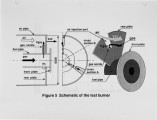| OCR Text |
Show concentration from the C/H-atomic weight balance of fuel gas, A' is expressed as: A' _ [CO] + 2[C02] + [H20] + 2[02] - ([CO] + 2[C02] + [H20]) + ([CO] + 4[CHJ + [HJ) The center of the combustion air stream shows a fuel-rich region of A' less than 1.0 suggesting the existence of fuel flow. At the edge of the combustion air stream, in contrast, A ' is more than 3.0, indicating poor mixing between the fuel gas and the combustion air near the air injection ports. The mixing proceeds along the combustion air stream. At roughly 400 mm downstream from the burner A' becomes more uniform, approaching the overall excess air ratio of 1.1. Reviewing the flame photograph, the major combustion appears to initiate at 400 mm downstream, where A' is in the range of 1.0-1.1 . Figure 15 snows the distribution of local EGR ratio y . Local EGR ratio y is expressed as the volume fraction of flue gas in the combustion air stream, calculated from the distnbution of measured gas species. Local EGR ratio y shows the degree of self-induced EGR in the combustion air stream. &suming that flue gas of the theoretical composition is entrained into the main combustion air stream, local EGR ratio y is expressed as: where' denotes the wet-base flue gas composition theoretically calculated from the measured CO2 concentration in the flue. Figure 15 shows that a substannal amount of flue gas is entrained into the very center of the combustion air stream. Local EGR ratio y increases along the main forward air stream, approaching as much as 50% at 400 mm downstream of the burner where the ignition is thought to initiate. While entraining high temperature flue gas, the combustion air stream mixes with fuel gas in its center. Combustion appears to initiate when the temperature and excess air ratio satisfy the condition for ignition. Since the flame is lifted, flue gas is |























